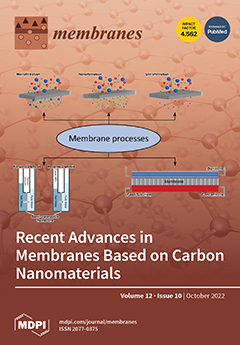The separation of C
3 olefin and paraffin, which is essential for the production of propylene, can be facilitated by the ZIF-8 membrane. However, the commercial application of the membrane has not yet been achieved because the fabrication process does not meet industrial
[...] Read more.
The separation of C
3 olefin and paraffin, which is essential for the production of propylene, can be facilitated by the ZIF-8 membrane. However, the commercial application of the membrane has not yet been achieved because the fabrication process does not meet industrial regulatory criteria. In this work, we provide a straightforward and cost-effective membrane fabrication technique that permits the rapid synthesis of ZIF-8 hollow fiber membranes. The scalability of the technology was confirmed by the incorporation of three ZIF-8 hollow fiber membranes into a single module using an introduced fiber mounting methodology. The molecular sieving characteristics of the ZIF-8 membrane module on a binary combination of C3 olefin and paraffin (C
3H
6/C
3H
8 selectivity of 110 and a C
3H
6 permeance of 13 GPU) were examined at atmospheric conditions. In addition, the high-pressure performance of these membranes was demonstrated at a 5 bar of equimolar binary feed pressure with a C
3H
6/C
3H
8 selectivity of 55 and a C
3H
6 permeance of 9 GPU due to propylene adsorption site saturation. To further accurately portray the separation performance of the membrane on an actual industrial feed, the effect of impurities (ethylene, ethane, butylene,
i-butane, and
n-butane), which can be found in C3 splitters, was investigated and a considerable decrement (~15%) in the propylene permeance upon an interaction with C4 hydrocarbons was confirmed. Finally, the long-term stability of the ZIF-8 membrane was confirmed by continuous operation for almost a month without any loss of its initial performance (C
3H
6/C
3H
8 separation factor of 110 and a C
3H
6 permeance of 13 GPU). From an industrial point of view, this straightforward technique could offer a number of merits such as a short synthesis time, minimal chemical requirements, and excellent reproductivity.
Full article






